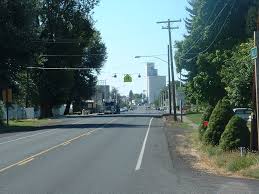GRASS VALLEY: THE TOWN
CATEGORY: GRASS VALLEY
PHOTOS: GRASS VALLEY MAIN STREET (HIGHWAY 97)
GRASS VALLEY FROM THE NORTH HILL


The town of Grass Valley had a population of about 270. That did not include the people from the neighboring ranches, which must have doubled the user population. Many of those people drove into town from the eastern part of the county on a gravel road that ran past our house. Each vehicle driving past left clouds of dust which seemed to pass right through the walls as if they were a sieve and settle on our furniture. Once, when my fastidious Aunt Verna (Uncle Everett’s wife) was visiting and Gracie and Mary were compelled to play the piano for her, she wiped one finger over the top of the piano and inquired in a shocked voice, “Is that DUST?!” It was dust alright!
Our house was separated from the main part of town by a park, and next to it a large rodeo grounds with race track, bleachers and a grandstand. Next to the grandstand were high fences made of horizontal wood planks that formed holding corrals and chutes for bucking horses and other rodeo animals. We loved to play in those corrals and in the grandstand. Later, all those structures were torn down and a new one-story grade school was built where the race track had been. If it had been there when we lived in Grass Valley, we would only have had to walk across the road to go to school instead of from one end of town to the other.
Grass Valley was a full-fledged, thriving little town back in the 1930’s before our lives became dominated by automobiles. After that, buying groceries in The Dalles on trips there for other necessities, such as doctors and dentists, saved money, so the towns started to diminish. Our town was typical of the towns that were spaced ten miles apart up the length of Sherman County. There were two grocery stores, a meat market, bank, post office, drug store, hardware/farm equipment store, a barber shop, library, hotel, garage, saddle/harness/shoe repair shop, movie theater, service station, a school house that housed the elementary grades plus a high school. There were three churches: Baptist, Methodist and Catholic. At the south end of town was a Tum-a-lum lumber company, the co-operative grain elevator and a fuel oil company. At the north end of town there was a park which was between the rodeo grounds and the highway on the east side. In the park was a large pavilion where dances and other public affairs were held. It had a stage which was used for lavish grade school Christmas plays. At the north end there was also our ranch, so close that it seemed to be in town since town houses were strung out along the highway to within a quarter mile of the ranch house.
I must also mention that there was a tavern in town, in front of which we, once or twice, encountered men whom we learned were “drunk,” a new experience for us since no one in our family drank anything stronger than coffee. We were instilled with a certain fear of anyone who had been drinking, and when we passed the tavern we felt guilty to even look in through the front door which was left open during the day time in warm weather. But I did look in at least once, for I vividly remember seeing, at its far end, the sun coming in through the open back door a half block away and illuminating a pathway into deep, dark space with tiny dust motes floating in the summer air. I think I was implanted at that time with a love of sun shining into mysterious places in interesting ways.
One pleasant feature, that we took for granted, was that our town had lots of trees. They were Cottonwoods and Silver Poplars, those kinds that grow easily from seeds that float through the air in cotton, like summer snow storms, and pile in drifts in the fence corners.
If my sister, Gracie, had been writing this, she would have first told about all the people: not just in Grass Valley but the whole county. She would have reiterated who was related to whom, who was sleeping with whom, who’s children were fathered by whom, whom they married or divorced, where they are now and what they are doing with their lives up to the present time. Her main interest has always been people. I am more interested in places–how they feel and look: hence my description of Grass Valley without people.
